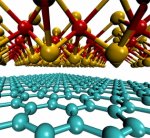New research from the Massachusetts Institute of Technology into graphene, one of the thinnest and most conductive photovoltaic materials in existence, could lead to the production of highly efficient solar panels that, weight-for-weight, could be capable of producing more energy than reactor-grade uranium.
In a paper published in the journal Nano Letters, MIT scientists describe the stacking of two atom-thick nanomaterials, graphene and molybdenum disulfide, to create a one-nanometre (billionth of a metre) thick solar cell capable of converting sunlight to energy at two percent efficiency.
Lead author of the research, Jeffrey Grossman, the Carl Richard Soderberg Associate Professor of Power Engineering at MIT, says while this is a very low number compared to conventional photovoltaic efficiencies, the solar cell is so thin that pound-for-pound the new material produces up to 1,000 times more power than current solar technology.
“It’s 20 to 50 times thinner than the thinnest solar cell that can be made today,” says Grossman. “You couldn’t make a solar cell any thinner.”
The research team also believe layering the ultra-thin solar cells could significantly improve their efficiency levels.
“Stacking a few layers could allow for higher efficiency, one that competes with other well-established solar cell technologies,” says Marco Bernardi, a postdoc in MIT’s Department of Materials Science.
The team foresee many applications for solar panels “thousands of times lighter and thinner than tissue paper”, such as on delicate structures like spacecraft and in the field of aviation. Shipping and installation cost could also fall dramatically.
Grossman says the results of this research into two-dimensional nanomaterials like graphene has exceeded expectations – and the field is still in its infancy. Molybdenum disulfide and molybdenum diselenide, used to produce the MIT results, are just two of an unexplored realm of highly-conductive photovoltaic nanomaterials, which could lead to groundbreaking discoveries in the field of solar energy.
“There’s a whole zoo of these materials that can be explored,” Grossman says. “My hope is that this work sets the stage for people to think about these materials in a new way.”












































